Book blocs
Invented in Rome by students at Sapienza University during protests in 2010, the book blocs system consists in citing books, such as Cervantes’ Don Quixote, and Melville’s Moby Dick, in order to make shields. In a piece from 2018, Jean- Baptiste Ganne used the system, adding his own references to create a library for survival. Perhaps he’s not the only one, and other artists might brandish other books this way…
/Book blocs
Where political activism, literature—and art—intersect
Using cardboard, sheets of plexiglass, spray paint, markers and string, book blocs1 are as easy to create as their impact is dramatic. They were invented by students at the Sapienza University of Rome in 2010 in protest against Berlusconi’s re-election. Then they traveled, in identical forms or with variations, always embodying—in a striking way—the idea that philosophy, literature and poetry can serve as defenses, if not weapons2 –since book blocs are, in fact, shields made for a crowd to combat the blows of police weaponry by brandishing the titles of books and the names of their authors (inscribed on sturdy bases all the same).3
With the 2018 installation Book Block4 including 31 pieces made using instructions posted on YouTube by the Roman protesters,5 Jean-Baptiste Ganne brings this practice into the real and symbolic world of art,6 expanding on the original question: what about art? Is it also an arm, or means of protection, against brutality holding society down? In this way Ganne’s work is as much about the role of artists in the struggle—finding out which side of power they’re on—as it is about “artist-readers”—in the words of the research collective that adopted the term (introduced by Lison Noël)7. Moreover, Ganne links the two ideas, well-versed in both the literature cited on the shields and the contexts they might serve. The work thus reveals two connections to the book in the context of this topic—reintroduced by demonstrations at the start of the 21st century—of possible interactions between activism and art (the “Art en Grève” movement, for one), with the front side of the work bearing the title and author’s name, the back side bearing straps to hold the object close to the body for protection. The symbolic impact is even greater for including books that aren’t exclusively militant or political. Among Ganne’s book blocks, naturally we find Now by the Invisible Committee, The Abolition of Work by Bob Black (and its predecessor The Right to be Lazy by Paul Lafargue), but also theoretical books on photography: Photography and Society by Gisèle Freund, Bourdieu’s Photography: a Middle-brow Art; and literature, Samuel Beckett’s End Game, Borges’ Fictions, Steinbeck’s Tortilla Flat, etc.
The selection’s diversity recalls that of the Roman originals, which brandished Melville’s Moby Dick, Garcia Marquez’ One Hundred Years of Solitude, Miller’s Tropic of Cancer… books written during different eras. The short list gives us an opportunity to emphasize how the book-shields obey the formal constraints of flat tints, names and titles—paratextual elements classified by Gérard Genette as “thresholds”8 opening onto the book’s whole world, while conditioning its reception. Reading a book’s cover is reading a small part of it, imagining it, or remembering the moment you read it—so powerful are these types of words, enough to call forth the book they refer to in full, if not the totality of all books. What’s more, used as a shield, the names and titles combine their symbolic power with the literal capacity to resist.
Could other artists brandish other books to be used as blocs? That is, would other artists, surely more tacitly, but with the same investment, Melville’s Bartleby might have come to mind already as the preferred book bloc for philosophers, from Blanchot to Agamben, who’ve written about it.9 The work was a reference for the Occupy Wall Street movement in 2011, and for Jean-Yves Jouannais in his Artistes sans œuvres: I would prefer not to.10
Bartleby, of course, is among the thirty-one shields of Jean-Baptiste Ganne. I must admit that the short story is the source of my piece here and the source of my thoughts on the power of certain books—in the case of Bartleby, markedly inversely proportional to the length of the text. Few works could give rise to as many interpretations and interpretations of interpretations, statements, and readings informed by contemporary issues.11
Still other books appear in artists’ work, books that they read and integrate into the art as texts expressive of their approach or sensibility.
Thus Anne-Valérie Gasc uses Ed Ruscha’s first three books from the early 1960s as the basis of her work, reinterpreting them in a truly incendiary way. For her, Twentysix Gasoline Stations from 1963, Various Small Fires and Milk from 1964 and Some Los Angeles Apartments from 1965, can be read in the light of Stéphane Mallarmé’s famous confession: “I know of no bomb other than a book,” transforming the series into a trilogy of fuel, ignition and target of attack. The bold reading is expressed in the work by reverse-engineering three small books that reproduce the layout of the original covers: Some Belsunce Apartments (2008) on gentrification in Marseille, Various Small Sparks (2014), on the dynamiting of ten high-rise buildings (the Démocratie towers in Vénissieux)12 and Twentysix Blank Rocks (2017)13 in which black ink is applied to old lithographic stones to make a book that has “the incendiary energy of all the words and phrases of all possible books, of every book imaginable.”14 Thus, we witness the displacement of the source book here, revealing its potential to exceed itself, to exit its register and travel well-beyond. Just as the Roman book blocs reduced books to a single color, name, and title, to better use them as a shield, Gasc reconfigures Ruscha’s work such that it produces the effect of a magical power able to defy the material world.
Defiance and destruction in Abundance of Life (1839) by German romantic author Tieck might be the book bloc of choice for Babeth Rambault. In the novel, a couple that’s intensely in love decides to burn the banister of the stairway leading to their apartment on the upper floor of a house, using it as firewood and cutting themselves off from the world. In Feu la rampe (Burn the Banister)(2012), the artist has her copy of the book undergo a similar procedure. Finding that the French translation of the novel (published by Aubier), has pages that tear out, one by one, as you turn them, like a book that autodestructs while you read it, Rambault altered her book by emphasizing this odd feature: she turned the book over, making the passage in which the action takes place the first page. “What interests me in this passage,” the artist states, “is that the characters’ decision to autonomous culminates in destroying the backbone of their connection to experience: the banister. They turn this sensibly essential element into a superfluous one, restoring its modest material identity as firewood.15 Again, here, intangible values are opposed to material ones, and the artist’s work on the book places that literally before our eyes. In this work, where the artist-reader takes on a radical form, the books interior becomes its title page, and potential shield, indicating, for those who take the trouble to read the text, a parable on the ideal of an autonomous life.
Other works by other artists, not imagining the book as an intellectual reference, but as a living resource that can be turned on at any moment, like the book blocs by the Roman protestors in 2010, await further exploration and the list will surely grow.16
But on the whole, to make this piece comprehensive and effective, we must also refer to other book blocs, this time fictitious, the “book people” at the end of Ray Bradbury’s science fiction novel Fahrenheit 451, for whom, if there’s something to save in a drifting world, it’s the books, because they can save us.
Notes :
1 The two spellings “book bloc” and “book block” are published. Since there’s no particular reason to choose one over another, I respected the preference of those who use the term.
2 This remark reflects the collective publication: Toi aussi tu as des armes. Poésie & politique, Paris, La Fabrique, 2011, the title of which, as Jacques-Henri Michot notes in his contribution, cites the last sentence of Kafka’s Journal, “More than consolation is: You too have weapons.” (D, 423), Kafka is expressing more of a consolation from oneself to oneself, in the end, than a warlike will to be spread. In this respect, it would be interesting to consider the difference between ‘arm’ and ‘defense.’
3 Later versions of book blocs exist, created with enlarged photocopies of published book covers. Given the poor quality (in general) of the models and the choice of iconography by classical publishers, I find them less attractive and less efficient than the Roman book blocs.
4 http://www.documentsdartistes.org/artistes/ganne/repro32.html
5The complete formula can be found here: https://www.youtube.com/watch? v=0pAea8o b8
6 First shown at the cooperative gallery Territoires Partagés in Marseille from 10/05/2018 to 30/06/2018, the installation was acquired by FRAC PACA http://www.lescollectionsdesfrac.fr/rechercher-et-voir-les-oeuvres-des-collections-des-frac#/ artwork/450000000095446?filters=collection%3AFrac%20Provence-Alpes- Côte%20d%27Azur,,authors%3AGANNE%20Jean-Baptiste↹GANNE%20Jean- Baptiste&page=1&layout=grid&sort=by_author
7 For an idea of the group’s work: https://www.centrepompidou.fr/fr/ressources/ media/X9pgPsF
8 In the book, Seuils, Paris, Seuil, 1987 (Paratexts: Thresholds of Interpretation, Cambridge University Press, 1997)—which is itself one of those books that elicits the reflection, “how have I lived so long without having read this?”—Genette devotes a chapter to the author’s name, with the following chapter on titles. He outlines the history of how they’ve been used and analyzes the ways in which they provide access to the text.
9 Gisèle Berkman, in L’Effet Bartleby. Philosophes Lecteurs, Paris, Hermann, 2011, brilliantly analyzes Blanchot, Deleuze, Derrida and Agamben’s readings (mentioning Jean-Luc Nancy’s less enthusiastic perspective).
10 Jean-Yves Jouannais, Artistes sans œuvres. I would prefer not to, Paris, Hazan, 1997. An extended second print was published by Gallimard in 2009, with a preface by Enrique Vila-Matas, author of Bartleby et Compagnie, a book that consists in a ghost text with footnotes, published in 2003 by Christian Bourgois.
11 One might sight a republication by Libertalia in 2020, with a new translation by Noëlle de Chambrun and Tancrède Ramonet, emphasizing the birth of financial capitalism on Wall Street as context.
I’ve personally run courses at ESAD in Reims for two years based on the short story, looking at it from many directions, such as “blind windows,” “the photocopy,” “bullshits jobs,” “ghosts”…
12 Archive INA: https://www.youtube.com/watch?v=Xk-Je1eQ5po
13 http://www.documentsdartistes.org/artistes/gasc/repro13-1.html http://www.documentsdartistes.org/artistes/gasc/repro13-4.html http://www.documentsdartistes.org/artistes/gasc/repro13-5.html
14 Interview with the author, January 2021
→ https://www.youtube.com/watch?v=SjDCCQMWZ98&t=1792s
15 Documents d’artistes Bretagne http://ddab.org/fr/oeuvres/Rambault/Page3
16 For an exhibition at the Cabinet du Livre d’Artiste, Rennes, autumn 2022.
Translation: Elaine Krikorian
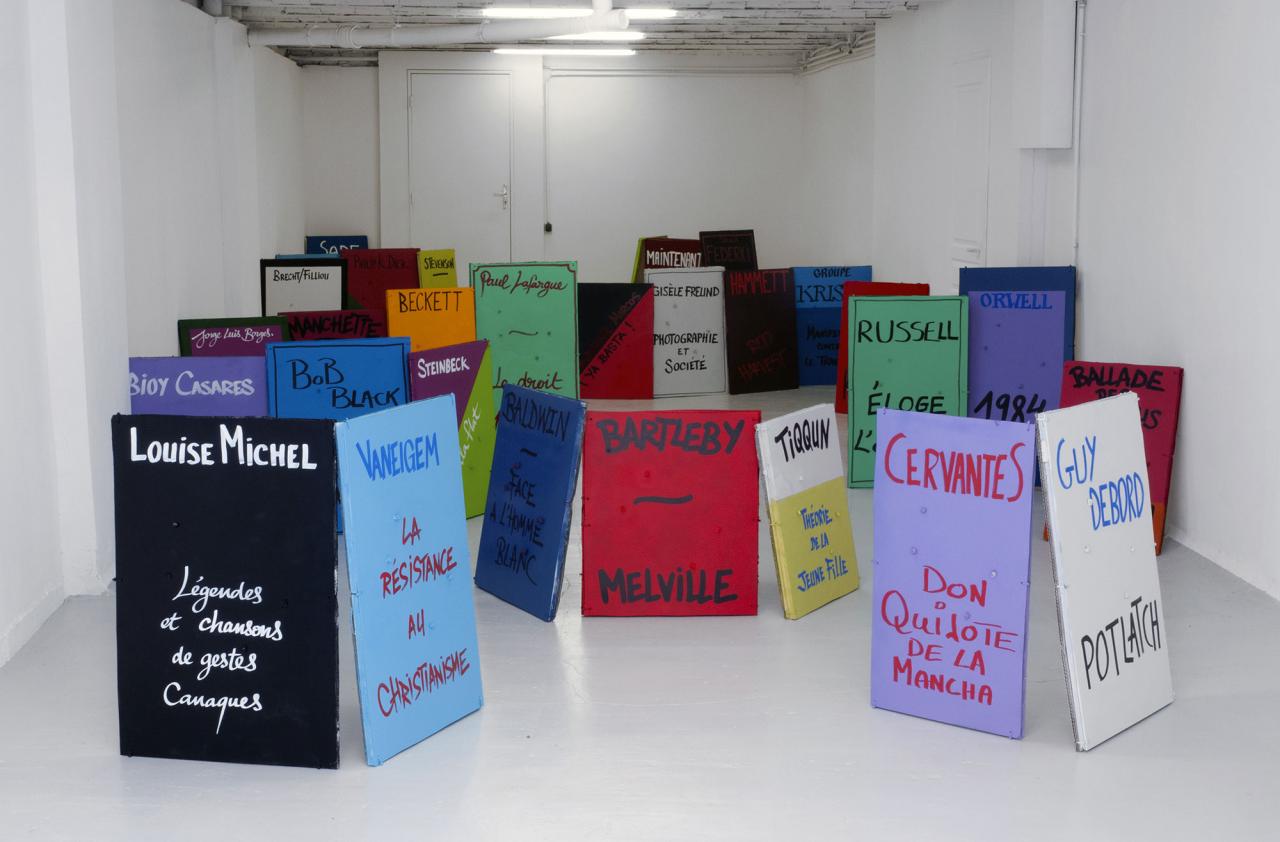
Techniques mixtes,
Détail de l’installation à la Galerie Territoires Partagés, Marseille, 2018, ©adagp
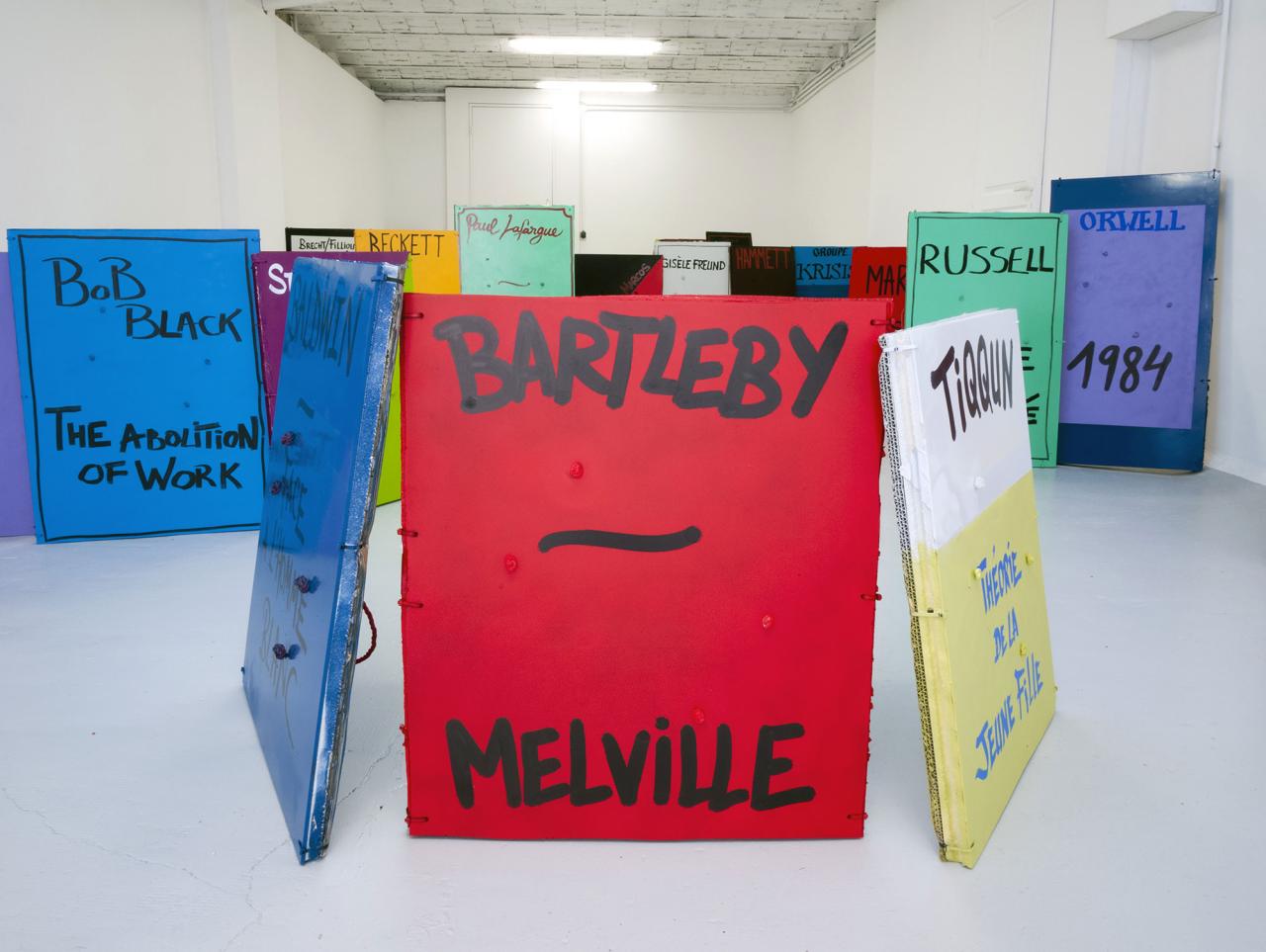
Techniques mixtes,
Détail de l’installation à la Galerie Territoires Partagés, Marseille, 2018, ©adagp

Techniques mixtes,
Détail de l’installation à la Galerie Territoires Partagés, Marseille, 2018, ©adagp
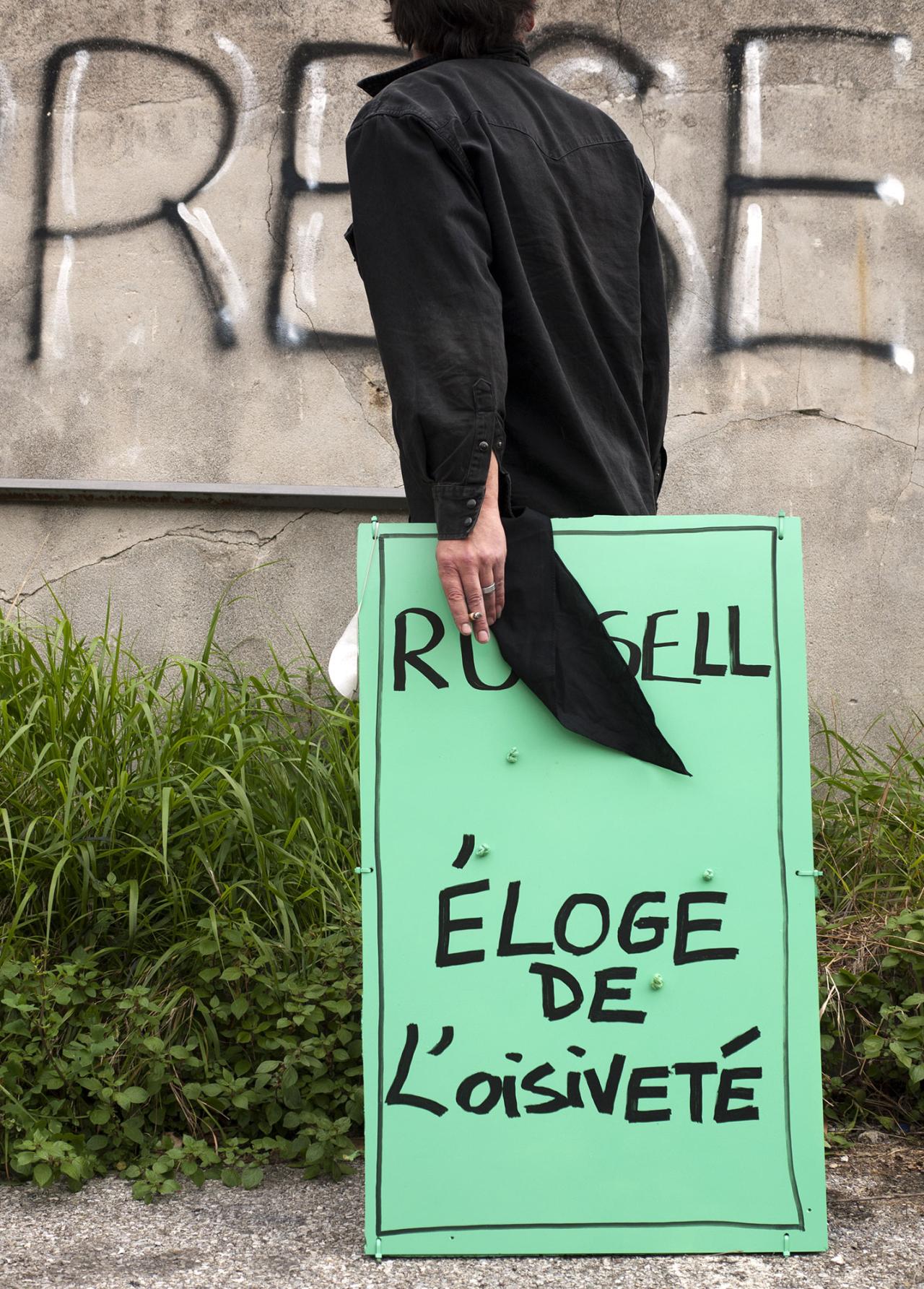
élément / détail de l’installation
Collection FRAC PACA, Marseille
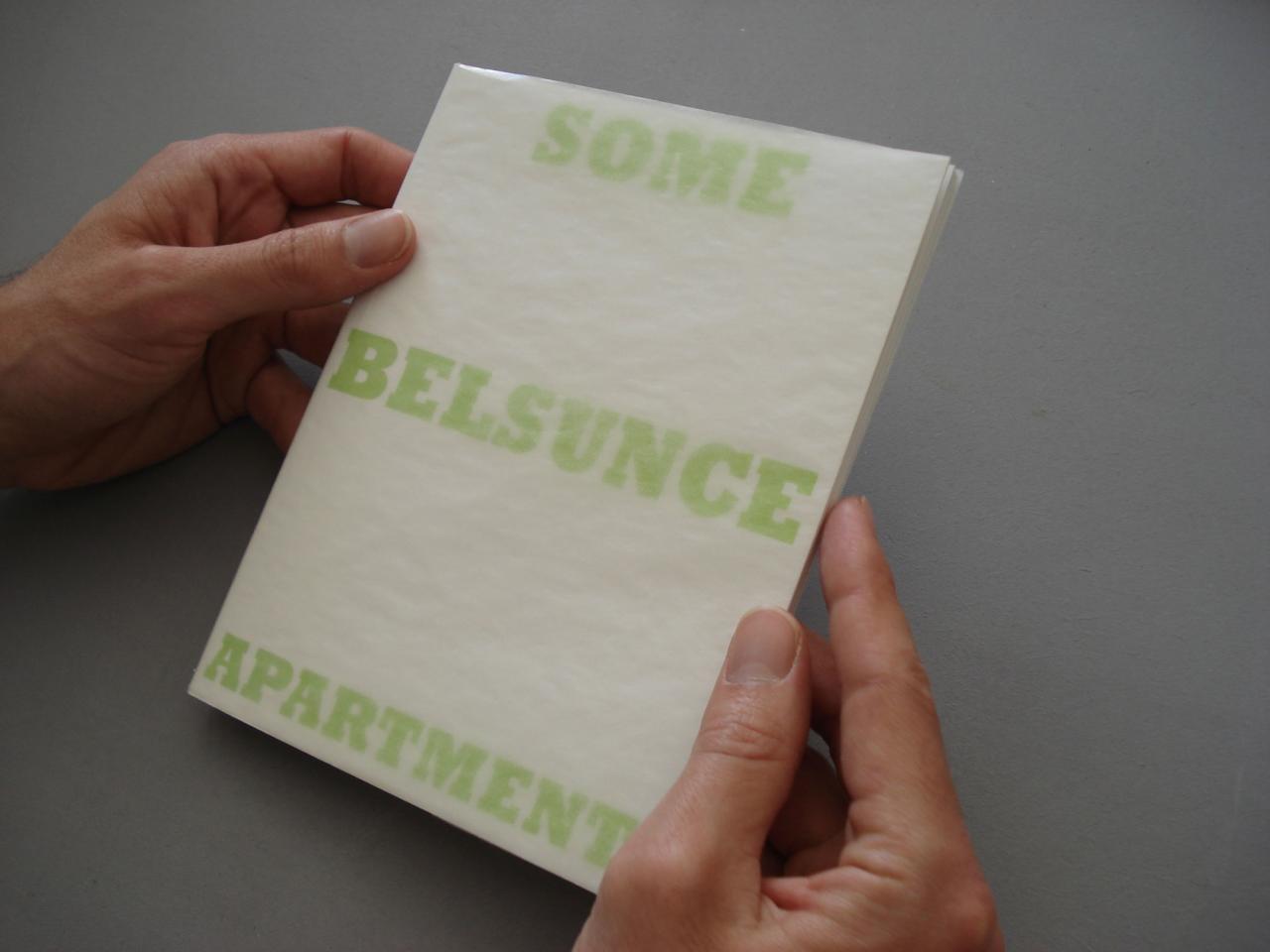
18 x 14,2 cm, 700 exemplaires, Auto-édition, Marseille + Herman Melville, Bartleby le scribe, Montreuil, Éditions Libertalia, 2020
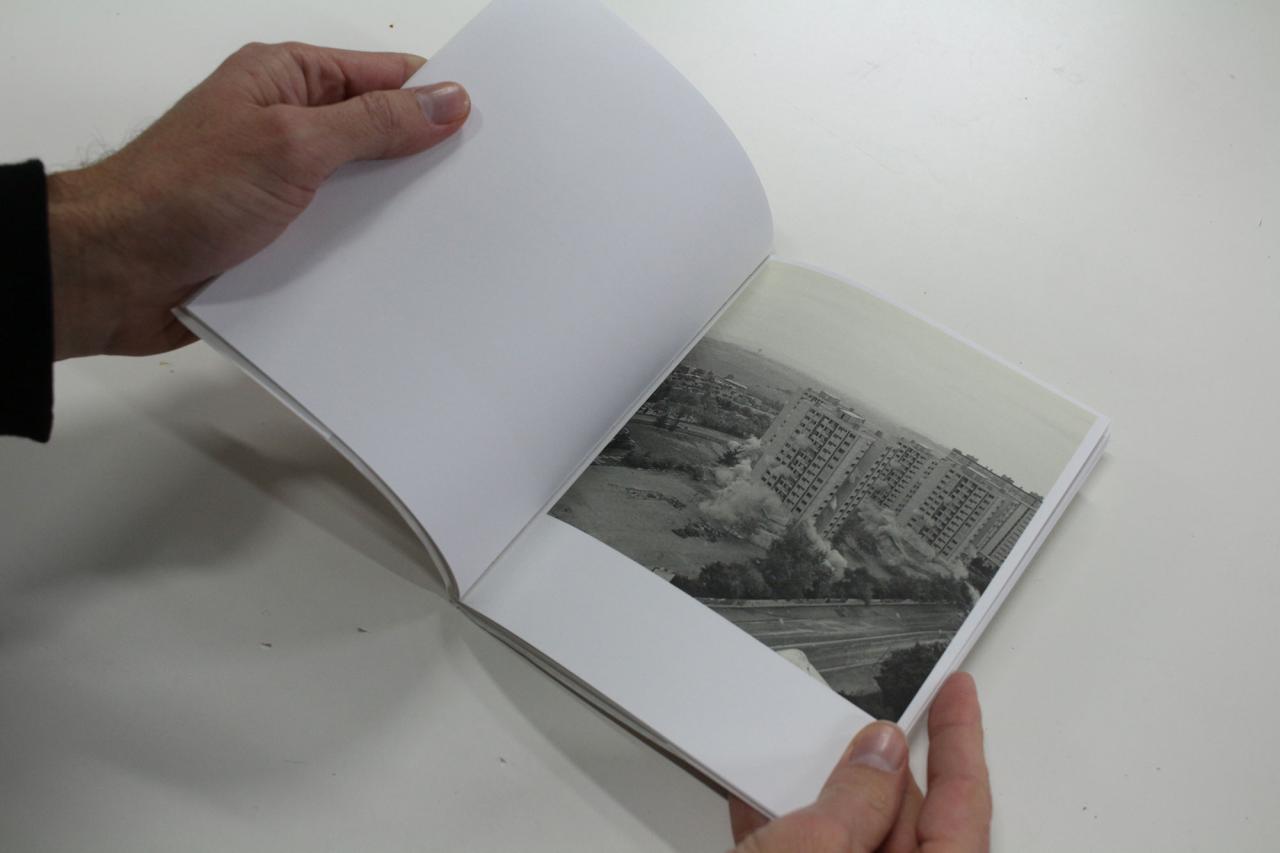
Livre d’artiste, 17,5 x 14 cm
Tirage 500 exemplaires dont 100 détruits
Édition Florence Lœwy, Paris, 2014
Avec le soutien du Conseil Départemental des Bouches-du-Rhône
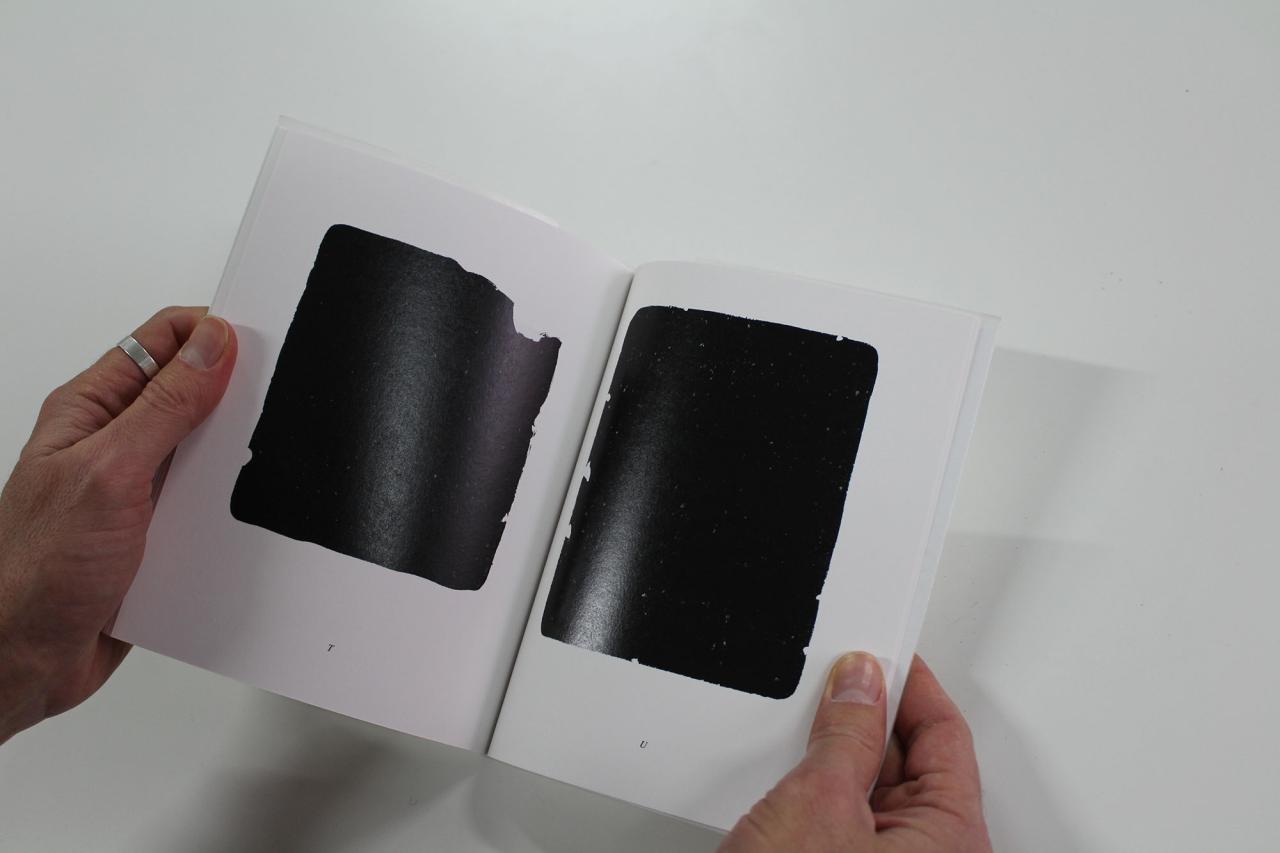
Tirage à 400 exemplaires, Lendroit Éditions, Rennes
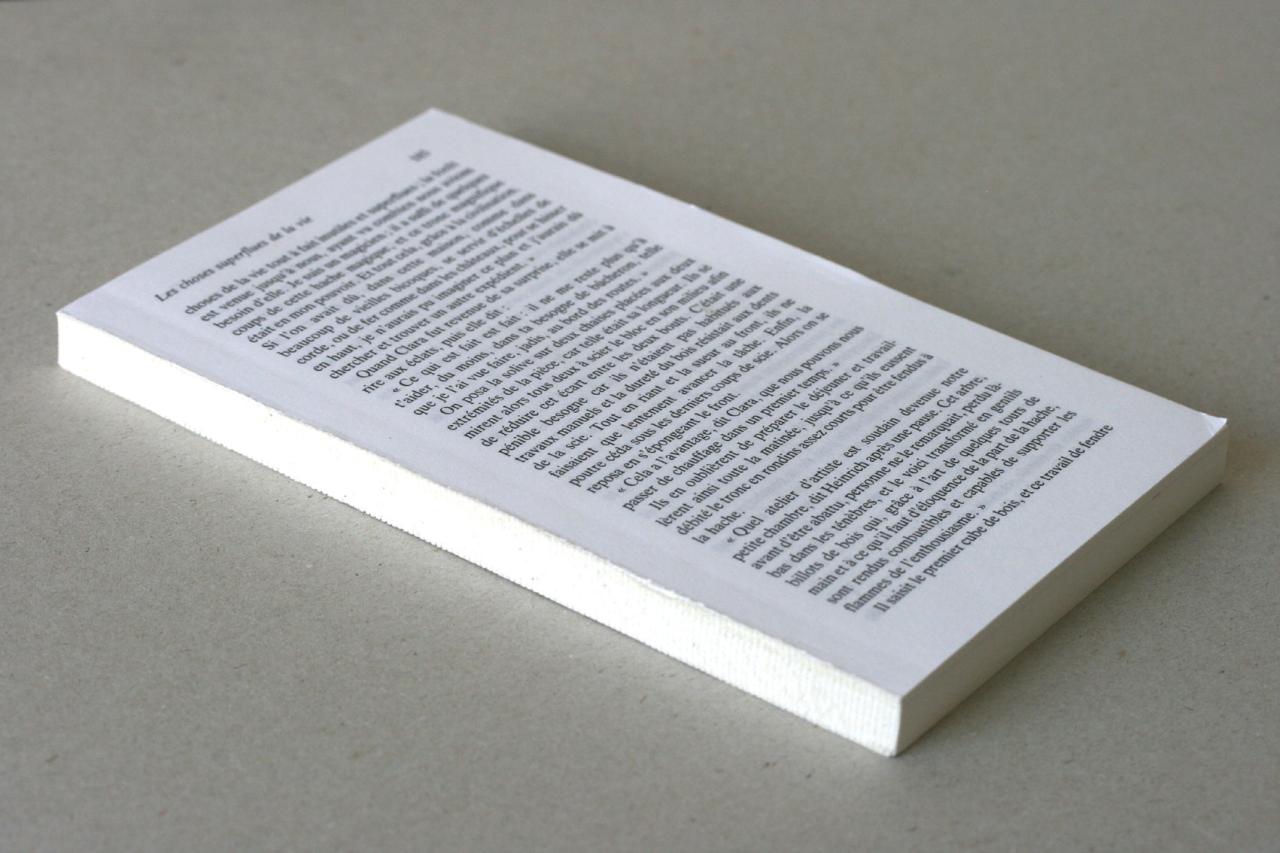
Intervention sur un livre existant
1,5 x 21,7 x 13 cm
Photo : Babeth Rambault, © adagp et l'artiste
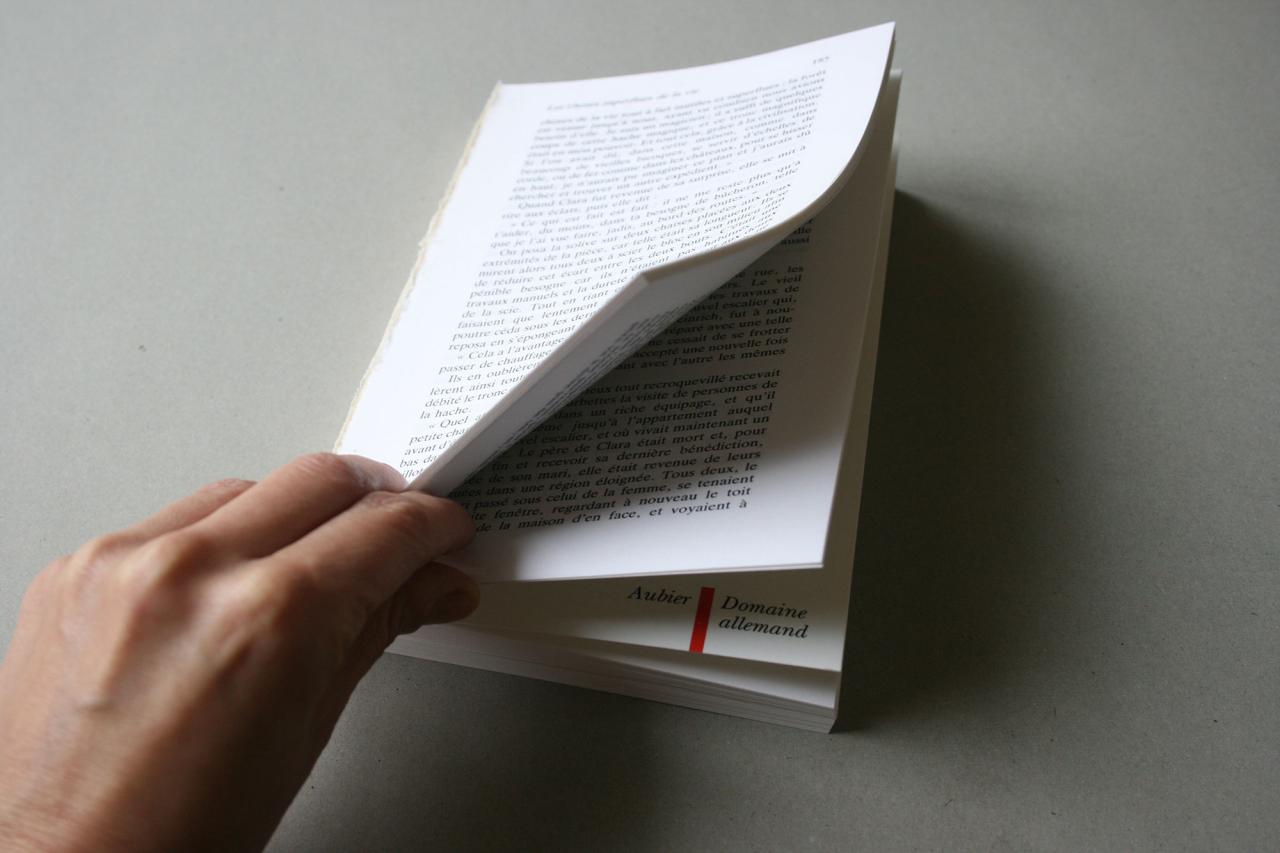
Intervention sur un livre existant
1,5 x 21,7 x 13 cm
Photo : Babeth Rambault, © adagp et l'artiste
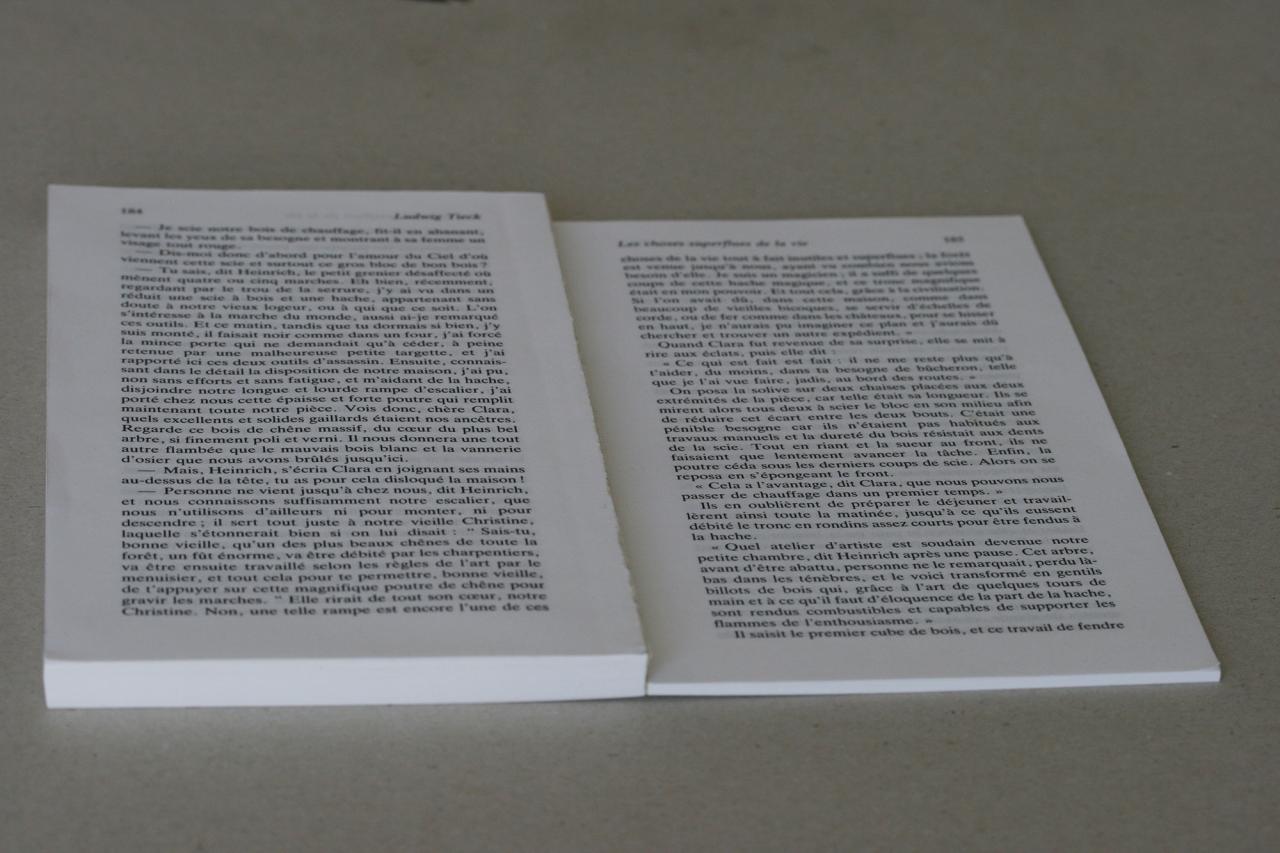
Intervention sur un livre existant
1,5 x 21,7 x 13 cm
Photo : Babeth Rambault, © adagp et l'artiste